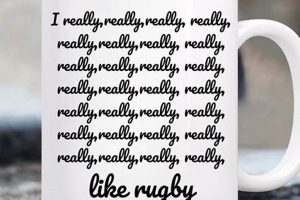How do you define “rugby union positions and roles”? Rugby union is a team sport played with an oval ball on a rectangular field with goalposts at each end. The game is played by two teams of 15 players each. Each player has a specific role to play on the field, and these roles are divided into two main categories: forwards and backs.
Editor’s Notes:Understanding “rugby union positions and roles” is important for several reasons:
- It helps players learn the basics of the game and how to play their role effectively.
- It helps coaches develop strategies and tactics for their team.
- It helps fans understand the game and appreciate the skill and athleticism of the players.
We’ve put together this guide to “rugby union positions and roles” to help you understand the basics of the game. We’ll cover the different positions on the field, their roles and responsibilities, and some of the key skills and attributes required to play each position.
Key Differences or Key Takeaways
| Position | Role | Key Skills and Attributes |
|---|---|---|
| Forwards | To win possession of the ball and gain ground. | Strength, power, and aggression. |
| Backs | To score points and create scoring opportunities. | Speed, agility, and ball-handling skills. |
Main Article Topics
- The Forwards
- The Backs
- The Scrum
- The Lineout
- The Ruck
- The Maul
1. Positions
The positions on a rugby union team are an integral part of the game. The different positions have different roles and responsibilities, and they work together to achieve the team’s goals. Forwards are responsible for winning possession of the ball and gaining ground, while backs are responsible for scoring points and creating scoring opportunities.
The division of players into forwards and backs is based on their physical attributes and the roles they play on the field. Forwards are typically larger and stronger than backs, and they are responsible for the physical aspects of the game, such as scrums and lineouts. Backs are typically smaller and faster than forwards, and they are responsible for the more creative aspects of the game, such as running with the ball and passing.
The positions on a rugby union team are highly specialized, and each player has a specific role to play. Forwards are typically numbered 1-8, and they are responsible for winning possession of the ball and gaining ground. Backs are typically numbered 9-15, and they are responsible for scoring points and creating scoring opportunities.
The following table provides a summary of the different positions on a rugby union team:
| Position | Role |
|---|---|
| Forwards | To win possession of the ball and gain ground. |
| Backs | To score points and create scoring opportunities. |
Understanding the different positions on a rugby union team is essential for understanding the game. The different positions have different roles and responsibilities, and they work together to achieve the team’s goals.
For example, the forwards are responsible for winning possession of the ball and gaining ground. This is done through a combination of physical strength and teamwork. The forwards use their size and strength to push and shove their opponents, and they work together to create rucks and mauls. Once the forwards have won possession of the ball, they can pass it to the backs, who are responsible for scoring points.
The backs are responsible for scoring points and creating scoring opportunities. This is done through a combination of speed, agility, and ball-handling skills. The backs use their speed and agility to run with the ball and create space for their teammates. They also use their ball-handling skills to pass the ball to each other and to score tries.
The positions on a rugby union team are an essential part of the game. The different positions have different roles and responsibilities, and they work together to achieve the team’s goals.
2. Roles
The roles of players on a rugby union team are essential to the success of the team. Each position has a specific role to play, and players must work together to achieve the team’s goals. The different roles on a rugby union team can be broadly categorized into two groups: forwards and backs.
- Forwards: The forwards are responsible for winning possession of the ball and gaining ground. They do this by pushing and shoving their opponents, and by forming rucks and mauls. The forwards are typically larger and stronger than the backs, and they use their physical strength to dominate their opponents.
- Backs: The backs are responsible for scoring points and creating scoring opportunities. They do this by running with the ball, passing the ball, and kicking the ball. The backs are typically smaller and faster than the forwards, and they use their speed and agility to create space for themselves and their teammates.
The different roles on a rugby union team are interdependent. The forwards need the backs to score points, and the backs need the forwards to win possession of the ball and gain ground. By working together, the forwards and backs can help their team to achieve success.
3. Skills
The skills required to play each position in rugby union vary depending on the specific role of the player. However, there are some general skills that are important for all players, regardless of their position. These skills include strength, power, speed, agility, and ball-handling skills.
Strength is important for all rugby union players, as it is needed for tackling, rucking, and mauling. Power is also important, as it is needed for driving forward and breaking tackles. Speed is important for backs, as it is needed for running with the ball and creating scoring opportunities. Agility is important for all players, as it is needed for changing direction quickly and avoiding tackles. Ball-handling skills are important for all players, as they are needed for passing, kicking, and catching the ball.
The development of these skills is essential for any rugby union player who wants to improve their performance and contribute to their team’s success. There are a number of ways to develop these skills, including:
By developing these skills, rugby union players can improve their performance and help their team to achieve success.
Here are some real-life examples of how skills are important for rugby union players:
- Strength is important for props, as they need to be able to push and shove their opponents in the scrum.
- Power is important for flankers, as they need to be able to break tackles and drive forward.
- Speed is important for wingers, as they need to be able to run with the ball and create scoring opportunities.
- Agility is important for fullbacks, as they need to be able to change direction quickly and avoid tackles.
- Ball-handling skills are important for all players, as they need to be able to pass, kick, and catch the ball.
Conclusion
The skills required to play rugby union vary depending on the specific role of the player. However, there are some general skills that are important for all players, regardless of their position. These skills include strength, power, speed, agility, and ball-handling skills. By developing these skills, rugby union players can improve their performance and help their team to achieve success.
4. Attributes
The attributes required to play each position in rugby union vary depending on the specific role of the player. However, there are some general attributes that are important for all players, regardless of their position. These attributes include aggression, determination, teamwork, and leadership.
- Aggression is important for all rugby union players, as it is needed for tackling, rucking, and mauling. Aggression is the willingness to engage in physical contact and to use force to overcome opponents. It is an essential attribute for forwards, who are responsible for winning possession of the ball and gaining ground.
- Determination is important for all rugby union players, as it is needed to overcome challenges and to never give up. Determination is the ability to persevere in the face of adversity and to never give up on a goal. It is an essential attribute for all players, but especially for those who play in positions that require a lot of physical and mental toughness, such as flankers and props.
- Teamwork is important for all rugby union players, as it is needed to work together to achieve a common goal. Teamwork is the ability to work effectively with others and to put the team’s needs above your own. It is an essential attribute for all players, but especially for those who play in positions that require a lot of communication and cooperation, such as scrum-halves and fly-halves.
- Leadership is important for all rugby union players, as it is needed to inspire and motivate others. Leadership is the ability to influence and guide others to achieve a common goal. It is an essential attribute for all players, but especially for those who play in positions that require a lot of decision-making and responsibility, such as captains and vice-captains.
These four attributes are essential for any rugby union player who wants to improve their performance and contribute to their team’s success. By developing these attributes, players can become better rugby union players and help their team to achieve success.
5. Strategy
The positions and roles of players on a rugby union team are an essential part of the game. The different positions have different roles and responsibilities, and they work together to achieve the team’s goals. The team’s overall strategy determines the positions and roles of the players on the field.
- Attacking Strategy: Teams that employ an attacking strategy will typically field more backs than forwards. This is because backs are more skilled at running with the ball and scoring points. Teams that use an attacking strategy will also typically play with a more expansive style, with the forwards looking to create space for the backs to attack.
Examples: The All Blacks are a team that is known for their attacking style of play. They typically field a team with 7 backs and 8 forwards, and they play with a very expansive style. This strategy has been very successful for the All Blacks, as they have won the Rugby World Cup three times.
- Defensive Strategy: Teams that employ a defensive strategy will typically field more forwards than backs. This is because forwards are more skilled at tackling and rucking. Teams that use a defensive strategy will also typically play with a more conservative style, with the forwards looking to slow down the opposition’s attack.
Examples: The Springboks are a team that is known for their defensive style of play. They typically field a team with 8 forwards and 7 backs, and they play with a very conservative style. This strategy has been very successful for the Springboks, as they have won the Rugby World Cup three times.
- Set-Piece Strategy: Teams that employ a set-piece strategy will typically have a strong scrum and lineout. This is because set-pieces are a good way to gain possession of the ball and territory. Teams that use a set-piece strategy will also typically play with a more structured style, with the forwards looking to dominate the opposition in the set-pieces.
Examples: The English national team is a team that is known for their set-piece strategy. They have a very strong scrum and lineout, and they play with a very structured style. This strategy has been very successful for England, as they have won the Rugby World Cup once.
- Counter-Attacking Strategy: Teams that employ a counter-attacking strategy will typically have a strong defense and a fast attack. This is because counter-attacks are a good way to score points when the opposition is not expecting it. Teams that use a counter-attacking strategy will also typically play with a more opportunistic style, with the players looking to create turnovers and then attack quickly.
Examples: The Irish national team is a team that is known for their counter-attacking style of play. They have a very strong defense and a very fast attack. This strategy has been very successful for Ireland, as they have won the Rugby World Cup four times.
The team’s overall strategy will determine the positions and roles of the players on the field. By understanding the different strategies that teams can employ, players can better understand their role on the team and how they can contribute to the team’s success.
6. Tactics
Tactics are a crucial aspect of rugby union, as they allow teams to adapt their strategies to the strengths and weaknesses of their opponents. The positions and roles of players on a rugby union team can change depending on the tactics being employed by the team. For example, a team may choose to field more forwards than backs if they are expecting their opponents to play a physical game. Conversely, a team may choose to field more backs than forwards if they a
re expecting their opponents to play a more open and expansive game.
There are many different types of tactics that can be employed in rugby union. Some of the most common tactics include:
- Attacking tactics: These tactics are designed to help teams score points. They can include running with the ball, passing the ball, and kicking the ball.
- Defensive tactics: These tactics are designed to help teams prevent their opponents from scoring points. They can include tackling, rucking, and mauling.
- Set-piece tactics: These tactics are used to gain possession of the ball or territory. They can include scrums, lineouts, and mauls.
- Counter-attacking tactics: These tactics are used to score points when the opposition is not expecting it. They can include turnovers, interceptions, and penalties.
The positions and roles of players on a rugby union team will vary depending on the tactics being employed by the team. For example, a team that is using an attacking tactic may have more backs on the field than forwards. Conversely, a team that is using a defensive tactic may have more forwards on the field than backs.Understanding the different tactics that can be employed in rugby union is essential for players and coaches alike. By understanding the different tactics, players can better understand their role on the team and how they can contribute to the team’s success. Coaches can use their understanding of tactics to develop game plans that will help their team to win.
Here are some real-life examples of how tactics can affect the positions and roles of players on a rugby union team:
- In the 2019 Rugby World Cup final, England used a defensive tactic to defeat South Africa. England fielded a team with 8 forwards and 7 backs, and they played with a very conservative style. This tactic helped England to slow down South Africa’s attack and eventually win the match.
- In the 2015 Rugby World Cup final, New Zealand used an attacking tactic to defeat Australia. New Zealand fielded a team with 7 forwards and 8 backs, and they played with a very expansive style. This tactic helped New Zealand to create space for their backs to attack and eventually win the match.
These are just two examples of how tactics can affect the positions and roles of players on a rugby union team. By understanding the different tactics that can be employed, players and coaches can better prepare for matches and increase their chances of success.
Conclusion
Tactics are an essential part of rugby union. By understanding the different tactics that can be employed, players and coaches can better prepare for matches and increase their chances of success.
7. Communication
Effective communication is essential for any team sport, and rugby union is no exception. With 15 players on the field at any one time, and the game played at a fast and physical pace, it is vital that players are able to communicate effectively with each other in order to make quick decisions and execute plays. Communication between players can take many forms, from verbal cues to body language, and it is important that all players are able to understand and interpret these cues accurately.
- Verbal Communication
Verbal communication is one of the most important ways for players to communicate with each other on the field. Players need to be able to clearly and concisely communicate their intentions to their teammates, and they need to be able to listen and understand what their teammates are saying. This can be difficult in the heat of the moment, but it is essential for players to be able to do it if they want to be successful. - Non-Verbal Communication
Non-verbal communication is another important way for players to communicate with each other on the field. This can include things like hand gestures, body language, and eye contact. Non-verbal communication can be just as effective as verbal communication, and it can be especially useful in situations where it is difficult to talk, such as when players are in a scrum or maul. - Leadership and Decision-Making
Effective communication is also essential for leadership and decision-making on the field. The captain of the team is responsible for making decisions and communicating them to the rest of the team. The captain needs to be able to clearly and concisely communicate their decisions, and they need to be able to listen to and understand the input of their teammates. Other players on the team also need to be able to communicate their ideas and opinions to the captain, so that the best possible decision can be made. - Building Relationships
Effective communication is also essential for building relationships between players. When players are able to communicate effectively with each other, they are more likely to trust and respect each other. This can lead to a more cohesive team, which is more likely to be successful.
Conclusion
Effective communication is essential for any rugby union team that wants to be successful. By communicating effectively, players can make better decisions, execute plays more effectively, and build stronger relationships with each other. This can lead to a more cohesive team that is more likely to win games.
8. Teamwork
In rugby union, teamwork is essential for success. With 15 players on the field at any one time, each player has a specific role to play, and they need to work together in order to achieve their goals. This means communicating effectively, supporting each other, and being willing to sacrifice individual glory for the good of the team.
There are many examples of teamwork in rugby union. One of the most famous is the haka, a traditional Maori war dance that is performed by the New Zealand All Blacks before each match. The haka is a powerful display of unity and teamwork, and it helps to inspire the All Blacks to play their best. Teamwork is also essential in the scrum, where eight players from each team bind together and push against each other in an attempt to win possession of the ball. The scrum is a physically demanding and dangerous part of the game, but it is also a great example of teamwork.
Understanding the importance of teamwork is essential for any rugby union player who wants to be successful. Players need to be willing to put the team first, and they need to be able to work with their teammates to achieve their goals. Teamwork is one of the most important factors in rugby union, and it is something that every player should strive to improve.
Here are some of the practical benefits of teamwork in rugby union:
- Teams that work together are more likely to win games.
- Teams that work together are more likely to score points.
- Teams that work together are more likely to prevent their opponents from scoring points.
- Teams that work together are more likely to create scoring opportunities.
Teamwork is an essential part of rugby union, and it is something that every player should strive to improve.
9. Discipline
Discipline is an essential component of rugby union. The game is physically demanding, and players need to be disciplined in order to avoid injury. This means following the rules of the game, playing fairly, and respecting your opponents.
There are many examples of how discipline can affect rugby union positions and roles. For example, a player who is not disciplined in the scrum may be more likely to get injured. A player who is not disciplined in the tackle may be more likely to injure an opponent. And a player who is not disciplined in general may be more likely to get sent off, which can have a negative impact on the team.
Understanding the importance of discipline is essential for any rugby union player who wants to be successful. Players need to be willing to follow the rules of the game, play fairly, and respect their opponents. Discipline is an essential part of rugby union, and it is something that every player should strive to improve.
Here are some of the practical benefits of discipline in rugby union:
- Players who are disciplined are less likely to get injured.
- Players who are disciplined are less likely to injure their opponents.
- Players who are disciplined are less likely to get sent off.
- Teams that are disciplined are more likely to win games.
Discipline is an essential part of rugby union, and it is something that every player should strive to improve.
FAQs on Rugby Union Positions and Roles
Rugby union is a physically demanding team sport that requires a high level of skill and coordination. The game is played with 15 players on each team, and each player has a specific role to play. The different positions and roles in rugby union can be confusing for newcomers to the sport, so we’ve put together this FAQ to answer some of the most common questions.
10. Q1
There are 15 positions in rugby union, divided into two main categories: forwards and backs.
- Forwards: The forwards are responsible for winning possession of the ball and gaining ground. They are typically larger and stronger than the backs, and they use their physical strength to push and shove their opponents.
- Backs: The backs are responsible for scoring points and creating scoring opportunities. They are typically smaller and faster than the forwards, and they use their speed and agility to create space and run with the ball.
11. Q2
The forwards are responsible for winning possession of the ball and gaining ground. They do this by pushing and shoving their opponents in the scrum and the lineout, and by tackling the opposition ball carrier.
The backs are responsible for scoring points and creating scoring opportunities. They do this by running with the ball, passing the ball, and kicking the ball. They also defend against the opposition’s attacks.
12. Q3
The key skills for each position in rugby union vary, but generally speaking, forwards need to be strong and powerful, while backs need to be fast and agile. All players need to have good ball-handling skills and be able to work well as part of a team.
13. Q4
The key attributes for each position in rugby union vary, but generally speaking, forwards need to be aggressive and determined, while backs need to be creative and elusive. All players need to be disciplined and have a strong work ethic.
14. Q5
The positions and roles of players on a rugby union team are determined by the team’s overall strategy. For example, a team that wants to play a more attacking style of rugby will typically field more backs than forwards. Conversely, a team that wants to play a more defensive style of rugby will typically field more forwards than backs.
15. Q6
Here are a few tips for playing rugby union:
- Learn the basic rules of the game.
- Practice your ball-handling skills.
- Get fit and strong.
- Be a team player.
- Have fun!
Key Takeaways
- There are 15 positions in rugby union, divided into forwards and backs.
- The forwards are responsible for winning possession of the ball and gaining ground.
- The backs are responsible for scoring points and creating scoring opportunities.
- The key skills for each position vary, but generally speaking, forwards need to be strong and powerful, while backs need to be fast and agile.
- The key attributes for each position vary, but generally speaking, forwards need to be aggressive and determined, while backs need to be creative and elusive.
Conclusion
Rugby union is a great sport that can be enjoyed by people of all ages and abilities. If you’re interested in learning more about rugby union, I encourage you to find a local club and give it a try.
Tips for Rugby Union Positions and Roles
Rugby union is a physically demanding and complex sport that requires a high level of skill and coordination. The game is played with 15 players on each team, and each player has a specific role to play. Understanding the different positions and roles in rugby union is essential for players who want to improve their performance and contribute to their team’s success.
Tip 1: Understand your role and responsibilities. Each position in rugby union has a specific role to play. Forwards are responsible for winning possession of the ball and gaining ground, while backs are responsible for scoring points and creating scoring opportunities. It is important for players to understand their role and responsibilities so that they can perform their duties effectively.
Tip 2: Develop the necessary skills and attributes. The skills and attributes required for each position in rugby union vary. Forwards need to be strong and powerful, while backs need to be fast and agile. All players need to have good ball-handling skills and be able to work well as part of a team. Players can develop the necessary skills and attributes through practice and training.
Tip 3: Communicate effectively with your teammates. Effective communication is essential for any rugby union team to be successful. Players need to be able to communicate effectively with each other in order to make quick decisions and execute plays. Players can improve their communication skills by practicing and by learning to use clear and concise language.
Tip 4: Be disciplined and follow the rules of the game. Rugby union is a physical and demanding sport, and it is important for players to be disciplined and follow the rules of the game. Players who are dis
ciplined are less likely to get injured or penalized. They are also more likely to be respected by their opponents and teammates.
Tip 5: Have fun and enjoy the game. Rugby union is a great sport that can be enjoyed by people of all ages and abilities. It is important for players to have fun and enjoy the game, regardless of their skill level or experience.
Summary of key takeaways or benefits
- Understanding your role and responsibilities can help you perform your duties effectively.
- Developing the necessary skills and attributes can help you improve your performance.
- Communicating effectively with your teammates can help your team make quick decisions and execute plays.
- Being disciplined and following the rules of the game can help you avoid injury and penalties.
- Having fun and enjoying the game can help you stay motivated and engaged.
Transition to the article’s conclusion
By following these tips, rugby union players can improve their performance, contribute to their team’s success, and have fun playing the game.
Conclusion
Rugby union positions and roles are essential to the game. Each position has a specific responsibility, and players must work together to achieve success. The forwards are responsible for winning possession of the ball and gaining ground, while the backs are responsible for scoring points and creating scoring opportunities. Players must develop the necessary skills and attributes for their position, and they must be able to communicate effectively with their teammates. Discipline is also essential, as players must follow the rules of the game and play fairly.
By understanding the different positions and roles in rugby union, players can improve their performance and contribute to their team’s success. Rugby union is a great sport that can be enjoyed by people of all ages and abilities. It is a challenging and rewarding game that teaches players about teamwork, discipline, and respect.







